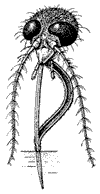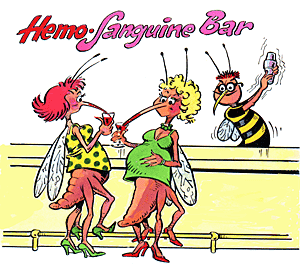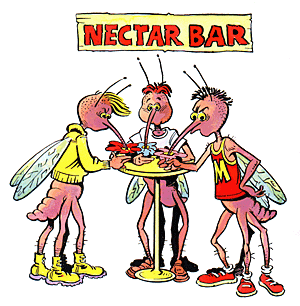Mosquitoes, Part 1
(the mosquito is the original skin diver)
The word mosquito entered English from Spanish
The name mosquito is Spanish for "little fly" and applies to any member of the insect family Culicidae, a group that comprises some 3 000 species and subspecies over virtually the entire earth. They also belong to the Diptera, the great order of flies. In this order there are many species of insects in which both the males and the females feed on blood; however, among mosquitoes, only the females consume blood.



These illustrations show the stylet bundles of mosquitoes piercing, while their sheaths (labium) bend and the stylets come out of the grooves. A stylet is “a long thin pointed instrument”. More illustrations are shown below.
- The finely toothed maxillae of the fascicle begin sawing into the tissue of the skin with fine back-and-forth movements. A fascicle is “a bundle of muscle or tendon fibers”.
- The fascicle is guided into the skin between the labella.
- As it goes into the skin the labium folds back like a hairpin and the mosquito shifts its legs closer to its body.
- When about half of the length of the fascicle has been inserted into the skin, the mosquito begins to draw blood.
- After the mosquito’s abdomen is filled, she straightens her front legs to quickly withdraw the fascicle.
- The fascicle springs upward and forward out of the wound and is fitted back into the deep groove in the labium.
- Among mosquitoes, it has been established that only the females desire and extract blood.
- Male mosquitoes drink only sugary fluids such as flower nectar. Both in the wild and in the laboratory, mosquitoes will visit certain flowers and will feed on fruit placed in their cage.
- Since they vigorously probe the flowers of some plants, and can distinguish between different types of sugars, they play a role in the pollination of certain plants.
- The females will also drink sugary fluids, but when hungry females are given a choice between sugar water and blood, they will always choose blood.
- If males are offered the same choice, they will always drink the sugar water.
- Since male mosquitoes do not suck blood, they also do not transmit diseases. Like the males of many other insect families, they are important for just one reason, and then they become superfluous.
- The female usually needs to mate just once in her life. She stores sperm in her body and fertilizes her eggs at the moment when she lays them. Shortly before or after mating, she takes a meal of blood to provide the eggs with protein.
- When the eggs are mature and ready to be fertilized, the female searches for a suitable place to lay them which is usually water that is full of decaying matter that includes bacteria and minute organisms.
- Some mosquito species lay their eggs in places that are likely to contain water in the future; such as, rusty coffee cans, old discarded tires, etc. In such situations, the eggs lapse into a state called diapause and they will not hatch until this dormant period passes, and the water level, temperature, and oxygen content are just right.
- The eggs of some species can survive for years in diapause, even in sub-freezing temperatures.
- After hatching from the eggs, they swim about and begin to feed by sweeping the water with two large fan-shaped bundles of chitinous bristles (or brush-like structures) at either side of their heads.
- The fans, or brushes, create currents in the water that direct food toward the larvae's mouthparts and help stuff the food into their deeply concealed mouths.
- The larvae are omnivorous; feeding on bacteria, pollen, microscopic plants, and a wide variety of other minute things.
- About 150 species live in the United States, more than 3,000 worldwide.
- They don’t really sting, in the sense of a hypodermic needle piercing the skin.
- They saw their way through instead, using four cutting stylets kept in a protective sheath along with a duct that carries anticoagulant into the wound and a tube that carries blood out.
- Mosquitoes fly into the wind, picking up scents which lead them to their victims. Just about everything attracts them, including the carbon dioxide we exhale.
- Mosquitoes will even suck the blood of birds, frogs, turtles, snakes and just about every warm-blooded animal. In fact, some mosquitoes prefer their sources of blood to be other than human. There are many species of mosquitoes that prefer the blood of birds or other animals. In fact, some species have been observed to feed on numerous mammalian groups, on a variety of reptilian species, and even on other kinds of insects.
- Anthropophilic mosquitoes are attracted to certain ranges of temperature and humidity, and to carbon dioxide from the exhalation of humans.
- They seem to prefer dark-colored objects to light. Certain chemical smells may also come into play; for example, components of blood and sweat such as hemoglobin and amino acids.
- The best explanation of what brings the mosquito to its victim is that she simply flies upwind until she comes upon a potential victim exuding a "host beam" of warm, moist air laden with carbon dioxide.
- The mosquito proboscis (long tubular mouth parts used for feeding) consists of six different shafts. Four are cutting and piercing tools; a fifth transports blood from the host; the sixth transports saliva, thought to act as an anticoagulant for the blood going in the other direction.
- The saliva also transmits the organisms of malaria, yellow fever, dengue, and most of the other diseases for which mosquitoes are notorious.
- When a mosquito punctures ("bites") into the flesh, one usually feels an allergic reaction to the saliva, which causes the swelling and the itch. The fact that this reaction is allergic helps explain why some people suffer more than others when their skins are invaded.
- Some mosquito species are nocturnal, diurnal, or crepuscular (active at dawn and twilight). They also differ in their preferences for altitudes.

I can’t deceive the smart mosquito;
While others also have corpuscles,
Mine are the ones toward which she hustles;
My blood is thin and I have asthma;
She doesn't care, she wants my plasma.
Mosquitoes seem to love the rind of me,
The front, the sides, and the behind of me;
I've tried to think why they're so smitten,
And as I think, once more I'm bitten.

 mosquitoes, Part 2
mosquitoes, Part 2
A cross reference of other word family units that are related directly, or indirectly, with: "insects, bugs, worms; invertebrates": aphidi-; api-; ascari-; culci-; Dung Beetle Survival; Dung Beetles Important; Eating Worms; entomo-; formic-; Guinea worms; helmintho-; insecto-; Insects: Importance; isopter-; larvi-; lepidopter-; meliss-; mosquito; Mosquito, other Languages; Mosquitoes, Pt. 2; myrmeco-; scarab; scoleco-; sphec-; taeni-; termit-; vermo-.
